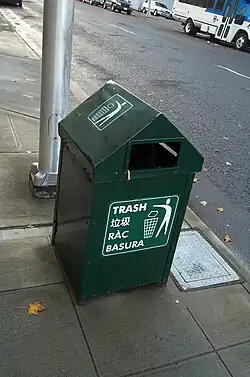The linguistic landscape refers to the "visibility and salience of languages on public and commercial signs in a given territory or region".[1] Linguistic landscape research has been described as being "somewhere at the junction of sociolinguistics, sociology, social psychology, geography, and media studies".[2] It is a concept which originated in sociolinguistics and language policy as scholars studied how languages are visually displayed and hierarchised in multilingual societies, from large metropolitan centers to Amazonia.[3] For example, linguistic landscape scholars have described how and why some public signs in Jerusalem are presented in Hebrew, English, and Arabic, or a combination thereof.[4][5] It also looks as how communication in public space plays a crucial role in the organisation of society.[6]
Development of the field of study

Studies of the linguistic landscape have been published from research done around the world. The field of study is relatively recent; "the linguistic landscapes paradigm has evolved rapidly and while it has a number of key names associated with it, it currently has no clear orthodoxy or theoretical core".[7] A special issue of the International Journal of Multilingualism (3.1 in 2006) was devoted to the subject. Also, the journal World Englishes published a themed issue of five papers as a "Symposium on World Englishes and Linguistic Landscapes: Five Perspectives" (2012, vol. 31.1). Similarly, an entire issue of the International Journal of the Sociology of Language (228 in 2014) was devoted to the subject, including looking at signs that show influences from one language on another language. In 2015 an academic journal devoted to this topic was launched, titled Linguistic Landscape: An International Journal, from John Benjamins. There is also a series of academic conferences on the study of linguistic landscape.[8] A comprehensive, searchable Linguistic Landscape Bibliography[9] is available.[10] A 2016 special issue of Manusya (number 22, 2016)[11] begins with a history and summary of the field.[12]
Because "the methodologies employed in the collection and categorisation of written signs is still controversial",[13] basic research questions are still being discussed, such as: "do small, hand-made signs count as much as large, commercially made signs?". The original technical scope of "linguistic landscape" involved plural languages, and almost all writers use it in that sense, but the scholar Papen has applied the term to the way public writing is used in a monolingual way in a German city[14] and Heyd has applied the term to the ways that English is written, and people's reactions to these ways.[15]
Multilingualism and monolingualism in signs

In much of the research the signs studied are multilingual signs, reflecting an expected multilingual readership. In other cases, there are monolingual signs in different languages, written in relevant languages found within a multilingual community.[16][17] Backhaus even points out that some signs are not meant to be understood so much as to appeal to readers via a more prestigious language (2007:58).
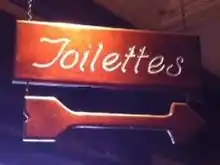
Some signs are spelled to convey the aura of another language (sometimes genuinely spelled as in the other language, other times fictionally), but are still meant to be understood by monolinguals. For example, some signs in English are spelled in a way that conveys the aura of German or French, but are still meant to be understood by monolingual English speakers. Similarly, some signs use Latin script that is aestheticized to look like Chinese characters or Cyrillic script, in order to evoke the associated languages while still being readable to people who don't know them. For example, Leeman and Modan (2010) describe the use of aestheticized Latin script in the Washington DC's Chinatown and the Arab Quarter of Granada, Spain.[18]
The study of linguistic landscape also examines such patterns as which languages are used for which types of institutions (e.g. country club, hospital, ethnic grocery store), which languages are used for more expensive/cheaper items (new cars or used cars), or which languages are used for more expensive/cheaper services (e.g. pool cleaning or washing machine repair). Also, the linguistic landscape can be studied across an area, to see which neighborhoods have signs in which languages. For example, Carr (2017) examined the languages of three cities in Southeast Los Angeles in her dissertation,[19] while Blommaert undertook an ethnography of his local neighbourhood in Antwerp, Belgium to examine how multilingual signs chronicles the complex social and cultural histories of a place.[20]
The languages used in public signs indicate what languages are locally relevant, or give evidence of what languages are becoming locally relevant (Hult 2009; Kasanga 2012). In many multilingual countries, multilingual signs and packaging are taken for granted, especially as merchants try to attract as many customers as possible or people realize that they serve a multilingual community (Hult, 2014). In other places, it is a matter of law, as in Quebec, where signs cannot be in English only, but must include French (Bill 101, Charte de la langue française). In Jerusalem it is legally required that 50% of a business's sign be in Hebrew.[21] In Texas, some signs are required to be in English and Spanish, such as warning signs about consuming alcohol while pregnant.
Linguistic landscape can also be applied to the study of competing scripts for a single language. For example, after the breakup of the Soviet Union, some signs in Mongolia were erected in the traditional Mongolian script, not just Cyrillic (Grivelet 2001). Similarly, in some Cherokee speaking communities, street signs and other public signage is written with the Cherokee syllabary (Bender 2008). Also, license plates in Greek Cyprus have been printed with Greek or Roman letters in different eras.[22]
Different approaches to linguistic landscape studies

More recently, scholars have rejected the purely quantitative approaches to Linguistic Landscape. For example, using Scollon and Scollon's (2003) framework of geosemiotics, researchers have analyzed the placement and relative size of different languages and signs.[23] Leeman and Modan (2009) proposed a "contextualized historical approach" to linguistic landscape that emphasizes the importance of considering how the signs came to be, and what they mean in a given context.[24] Their example of the different symbolic meanings of Chinese and English on Starbucks signs in Washington DC's Chinatown and a Shanghai shopping mall shows that it is unwise to draw conclusions based on the relative frequency of languages in signage.[24]
The study of the linguistic landscape can also show evidence of the presence and roles of different languages through history.[25][26] Some early work on a specific form of linguistic landscape was done in cemeteries used by immigrant communities,[27] some languages being carved "long after the language ceased to be spoken" in the communities.[28]
In addition to larger public signage, some who study linguistic landscapes are now including the study of other public objects with multilingual texts, such as banknotes in India which are labeled in over a dozen languages.[29]
Politics and the linguistic landscape
While the politics of language, particularly around which particular languages are privileged and which are not, has been an important focus for the discipline since its earliest beginnings,[1] the role that the linguistic landscape can play in politics more generally is increasingly becoming a topic for investigation. Seargeant's study of Political Activism in the Linguistic Landscape,[30] for example, examines how the UK activist group Led by Donkeys used a variety of sociolinguistic strategies drawing on the affordances of public space to expose acts of political hypocrisy. The book is also notable for using a graphic novel format to analyse its topic.
Linguistic landscape studies on areas of conflict
The study of language in post-war and conflict-ridden areas has also attracted the interest of scholars who applied the Linguistic Landscape approach as a method to explore how language use in the public space represents ethnic groups, reflects territorial conflicts, expresses statehood and projects ideologies and socio-cultural identities. Themistocleous (2019) for instance explored the use of Greek and Turkish on public signs in the centre of Nicosia (Cyprus) and found that traditional discourses of separation and conflict are dominant in the public space but at the same time new discourses of unification, peace and integration slowly begin to surface.[31]
Linguistic landscape in the Valencian community

Valencia is an officially bilingual city, where Valencian and Spanish populations coexist. In this territory the Valencian language lives in a situation of diglossia, and therefore the Valencian public institutions must maintain, protect and promote the use of the Valencian language. To ensure this, in 2005 the Valencia City Council developed "the Reglamento municipal sobre uso y normalización del valenciano en el municipio de Valencia" ("Municipal Regulations on the Use and Standardisation of Valencian Language in the Municipality of Valencia"[32]). The autonomous legislation of Valencia considers the use of Valencian as the preferred language for signs, banners, announcements, billboards, public road signs and toponyms. Moreover, the autonomous government and the municipal regulations from Valencia encourage private entities to use Valencian over Spanish in their efforts to raise the prestige and recognition of the language, which, despite being official, is used by minority throughout the territory.
Socially speaking, the Valencian Community is a territory with a great number of inhabitants who are either monolingual in Spanish, or bilingual in Spanish-Valencian, and it is a strongly touristy region. There is international tourism, especially from England and Northern Europe, and also national tourism. Among the use of other languages within the territory, the use of English is noteworthy as a lingua franca or vehicular language. For this reason, many shops use English in order to be accessible to a wider public. As described by Bruyèl-Olmedo and Juan-Garau, "among the number of languages featured on signs, shop fronts, billboards and the like, English enjoys a privileged position when it comes to addressing a multilingual, heterogeneous readership" [33]
Basque and Spanish languages
The Basque Country has invested in the protection of bilingualism, with particular regard to the introduction of measures aimed at ensuring the normalisation of the Basque language in institutions and the achievement of equal rights in its use and enjoyment for citizens, which at the moment is not fully achieved, especially in the working environment. In fact, according to the Unesco Atlas of the World's Languages in Danger, Basque is a minority and vulnerable language in its own territory, and is in an asymmetrical situation with respect to the other official language, Spanish. The challenge, therefore, is to bring the two official languages (Castilian and Euskara) up to the same level in practice, beyond the formal recognition they have already enjoyed since 1978, the year in which the newborn Constitution established in the second paragraph of Article 3 that all other languages should be equally official in their respective Autonomous Communities.[34]
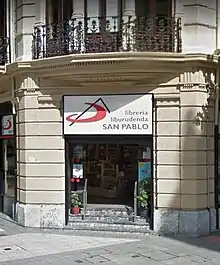
This historic concession constituted a decisive change of direction after the years of Franco's dictatorship, during which the regime had banned the use of the Basque language and attempted to erase its history and traditions.
The Statute of Autonomy of the Basque Country (1979), for its part, proclaimed the status of the Basque language as its own official language in the Autonomous Community of the Basque Country and the right of all persons to know and use both official languages (Article 6.1). Finally, Article 6.4 provided that the Royal Academy of the Basque Language-Euskaltzaindia is the official consultative institution with regard to Basque.[35]
Getting to the present day, in 2009 of the approximately two million people living in the Autonomous Community of the Basque Country, or Euskadi, only around 35% spoke Euskera, the Basque language, a non-Indo-European language isolate. Apart from that, notably Euskera had also a 9% of speakers in the Autonomous Community of Navarre and 26% in the Basque territories in the south of France.[36]
At the time, it was in the second year of the Basque Government's fourth planning period (2008-2012). Since then, the major intervention made is that contained in Decree 179/2019 of 19 November 2019, which gave to each local council the decision-making power on how to organise the use of both languages in its internal and public relations.
This decree put an end to the stage of a single rule for all local entities, and opened a new time in which each local institution could decide which language to use according to its sociolinguistic reality.
Among its objectives: to make Basque the language of work and of relations between administrations, to rationalise the use of translations and interpretations and to promote the use of the language in and from municipalities.[37]
Examples
 The three-language (Tamil, English and Hindi) name board at the Tirusulam railway station in South India. Almost all railway stations in India have signs in three or more languages (English, Hindi and the local language).
The three-language (Tamil, English and Hindi) name board at the Tirusulam railway station in South India. Almost all railway stations in India have signs in three or more languages (English, Hindi and the local language).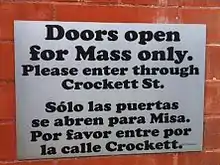 Spanish-English sign at Cathedral Santuario de Guadalupe in Dallas, Texas; the congregation has both English and Spanish speakers.
Spanish-English sign at Cathedral Santuario de Guadalupe in Dallas, Texas; the congregation has both English and Spanish speakers.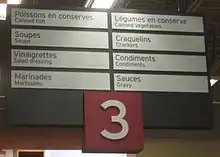 Bilingual sign in a Quebec supermarket with markedly predominant French text.
Bilingual sign in a Quebec supermarket with markedly predominant French text. A set of doors in Ivalo's S-Market thanking customers for having visited the store in the domestic languages of Finnish, Swedish, Northern Saami, Inari Saami, and Skolt Saami on the left. Finnish and four tourist languages — English, German, French, and Russian — on the right.
A set of doors in Ivalo's S-Market thanking customers for having visited the store in the domestic languages of Finnish, Swedish, Northern Saami, Inari Saami, and Skolt Saami on the left. Finnish and four tourist languages — English, German, French, and Russian — on the right.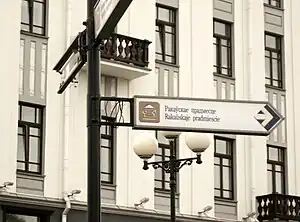
 English and Cherokee sign: Cherokee visually prominent but less functional.
English and Cherokee sign: Cherokee visually prominent but less functional.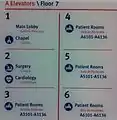 English and Spanish hospital directory, English prominent, in USA.
English and Spanish hospital directory, English prominent, in USA.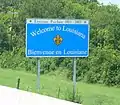 English and French sign in Louisiana, French written to indicate historical link, not so much to be understood
English and French sign in Louisiana, French written to indicate historical link, not so much to be understood Spanish church sign in Georgia, USA, addressed entirely to Spanish readers.
Spanish church sign in Georgia, USA, addressed entirely to Spanish readers. Washing machine repairman advertising on his truck, in English and Spanish, English on top, Texas
Washing machine repairman advertising on his truck, in English and Spanish, English on top, Texas Product originally labeled in English; bilingual warning base added for any hospital visitors & workers who are Spanish-dominant.
Product originally labeled in English; bilingual warning base added for any hospital visitors & workers who are Spanish-dominant.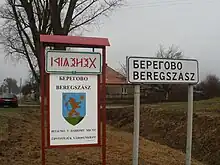 Bilingual sign, in three scripts, near Hungary-Ukraine border.
Bilingual sign, in three scripts, near Hungary-Ukraine border.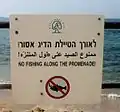 Sign in Israel written in Hebrew (official language), Arabic (widespread language), plus in English.
Sign in Israel written in Hebrew (official language), Arabic (widespread language), plus in English..JPG.webp) Sign in Roman script but Hebrew words, a hostel in Haifa, Israel catering to European gentiles
Sign in Roman script but Hebrew words, a hostel in Haifa, Israel catering to European gentiles This Spanish sign was advertising a mobile home for rent in a largely Hispanic neighborhood in Texas. The broader community is predominantly non-Spanish speaking.
This Spanish sign was advertising a mobile home for rent in a largely Hispanic neighborhood in Texas. The broader community is predominantly non-Spanish speaking. Commercial signs in section of Houston, Texas with large Asian population.
Commercial signs in section of Houston, Texas with large Asian population. Predominantly Spanish sign in Texas church working to welcome Spanish speakers, near English version of same sign
Predominantly Spanish sign in Texas church working to welcome Spanish speakers, near English version of same sign Chinese sign on restaurant in America, conveying Chinese aura but not propositional content.
Chinese sign on restaurant in America, conveying Chinese aura but not propositional content. Trilingual, biscriptal sign in Nunavut, Canada, using Canadian Aboriginal Syllabic script
Trilingual, biscriptal sign in Nunavut, Canada, using Canadian Aboriginal Syllabic script Hebrew gravestone in Germany
Hebrew gravestone in Germany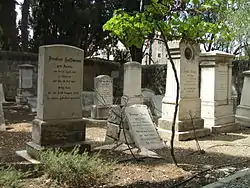 German gravestone in Israel
German gravestone in Israel Apartheid era trilingual sign in South Africa
Apartheid era trilingual sign in South Africa Gujarati and English sign on shop in English-speaking town in America, a Hindu talisman in the Gujarati language
Gujarati and English sign on shop in English-speaking town in America, a Hindu talisman in the Gujarati language Manila Oriental Market, grocery store in Daly, CA catering to many customers of Asian origin
Manila Oriental Market, grocery store in Daly, CA catering to many customers of Asian origin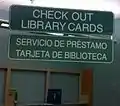 A library sign in English with Spanish below, in Texas. The city has many Spanish speakers moving in, so the public library has added Spanish books and Spanish signs.
A library sign in English with Spanish below, in Texas. The city has many Spanish speakers moving in, so the public library has added Spanish books and Spanish signs. Statue of Mariano Datahan in Bohol, Philippines, early promoter of the Eskayan language and script, labeled in Eskayan with its unique script
Statue of Mariano Datahan in Bohol, Philippines, early promoter of the Eskayan language and script, labeled in Eskayan with its unique script Vietnamese temple in Seattle, sign in three languages
Vietnamese temple in Seattle, sign in three languages Tombstone for Gurkha soldier who served in British army, in Gurkha and English
Tombstone for Gurkha soldier who served in British army, in Gurkha and English Mi'kmaq language stop sign in Elsipogtog First Nation, Canada, street names in English
Mi'kmaq language stop sign in Elsipogtog First Nation, Canada, street names in English Sign on building for Burmese refugees in USA
Sign on building for Burmese refugees in USA Signs in both Japanese and Portuguese in the Homi housing complex in the Homigaoka district of Toyota City, Japan, home to ethnic Japanese who have returned from Brazil
Signs in both Japanese and Portuguese in the Homi housing complex in the Homigaoka district of Toyota City, Japan, home to ethnic Japanese who have returned from Brazil In Fredericksburg, Texas founded by Germans, using German image for tourism. German part of the sign only for a German aura.
In Fredericksburg, Texas founded by Germans, using German image for tourism. German part of the sign only for a German aura.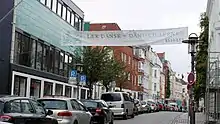 "Learn Danish" banner in Danish and German, in Flensburg, Germany where it is an officially recognised regional language.
"Learn Danish" banner in Danish and German, in Flensburg, Germany where it is an officially recognised regional language.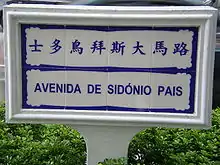
 Latin on altar and wall of cathedral in USA. Understood by few, but seen as holier by some.
Latin on altar and wall of cathedral in USA. Understood by few, but seen as holier by some. Sign specifically made for Spanish language church. Burglar alarm warning sign mass-produced, so English.
Sign specifically made for Spanish language church. Burglar alarm warning sign mass-produced, so English.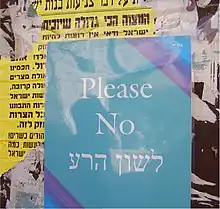 Sign in Jerusalem prohibiting slanderous speech
Sign in Jerusalem prohibiting slanderous speech Sign for government-run eye clinic in Yellowknife, Canada, with all 11 official languages of the Northwest Territories
Sign for government-run eye clinic in Yellowknife, Canada, with all 11 official languages of the Northwest Territories Multilingual signs at supermarket in Arlington, Texas. The area has many immigrants who speak Chinese, Vietnamese, or Spanish.
Multilingual signs at supermarket in Arlington, Texas. The area has many immigrants who speak Chinese, Vietnamese, or Spanish. Recycling site labeled in English, Hmong, Spanish, and Somali in Minneapolis
Recycling site labeled in English, Hmong, Spanish, and Somali in Minneapolis Coptic and Arabic inscription in old part of Cairo, from 1899
Coptic and Arabic inscription in old part of Cairo, from 1899 Maronite convent in Old Jerusalem: French, Latin, Arabic, Hebrew
Maronite convent in Old Jerusalem: French, Latin, Arabic, Hebrew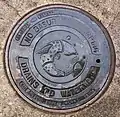 Manhole cover, San Antonio. English, except "No Basura!" ('No trash/waste!') in Spanish. "Made in India" in English
Manhole cover, San Antonio. English, except "No Basura!" ('No trash/waste!') in Spanish. "Made in India" in English
 Swedish trash can sign with five languages, reflecting growing population of refugees from Middle East
Swedish trash can sign with five languages, reflecting growing population of refugees from Middle East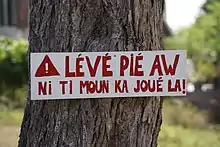 Though French is official on Martinique, sign is in Creole.
Though French is official on Martinique, sign is in Creole. Korean newspaper machines, Fresh Meadows, NY, labeled in Korean & English.
Korean newspaper machines, Fresh Meadows, NY, labeled in Korean & English. Sign in English, Chinese, Japanese, Spanish, and Arabic at Detroit Metropolitan Airport.
Sign in English, Chinese, Japanese, Spanish, and Arabic at Detroit Metropolitan Airport. The Romanian shop in Arcella district in Padua, Italy. Arcella is known for its multicultural population.
The Romanian shop in Arcella district in Padua, Italy. Arcella is known for its multicultural population. The four-language (Arabic, English, Russian, Italian) welcome board in Sharm el-Sheikh, Egypt. It has a nickname "The City of Peace" due to international peace conferences that had been held here, and now the nickname is being used to attract tourists.
The four-language (Arabic, English, Russian, Italian) welcome board in Sharm el-Sheikh, Egypt. It has a nickname "The City of Peace" due to international peace conferences that had been held here, and now the nickname is being used to attract tourists..jpg.webp)
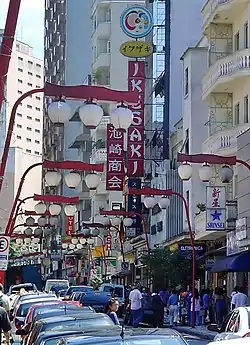 Japanese signs in a Japanese neighborhood in Sao Paulo. Brazil
Japanese signs in a Japanese neighborhood in Sao Paulo. Brazil.jpg.webp) Trilingual and triscriptal sign in Algeria: Arabic, Berber (written in Tifinagh), French
Trilingual and triscriptal sign in Algeria: Arabic, Berber (written in Tifinagh), French
Notes
- 1 2 Landry and Bourhis 1997:23
- ↑ Sebba, Mark (2010). "Review of Linguistic Landscapes: A Comparative Study of Urban Multilingualism in Tokyo.". Writing Systems Research. 2 (1): 73–76. doi:10.1093/wsr/wsp006. S2CID 144039684.
- ↑ Shulist, Sarah. 2018. Signs of status: language policy, revitalization, and visibility in urban Amazonia. Language Policy 17: 4, pp 523–543.
- ↑ Spolsky and Cooper 1991, The languages of Jerusalem. Clarendon Press.
- ↑ Ben-Rafael, Eliezer, Elana Shohamy, Muhammad Hasan Amara, and Nira Trumper-Hecht. "Linguistic landscape as symbolic construction of the public space: The case of Israel." International journal of multilingualism 3, no. 1 (2006): 7-30.
- ↑ Seargeant, Philip; Giaxoglou, Korina (2020), Georgakopoulou, Alexandra; De Fina, Anna (eds.), "Discourse and the Linguistic Landscape" (PDF), The Cambridge Handbook of Discourse Studies, Cambridge Handbooks in Language and Linguistics, Cambridge: Cambridge University Press, pp. 306–326, doi:10.1017/9781108348195.015, ISBN 978-1-108-42514-8, S2CID 201363082, retrieved 2023-06-13
- ↑ Sebba 2010:73
- ↑ "Linguistic Landscape 7 - 7-9 May 2015, UC Berkeley". berkeley.edu. Archived from the original on 11 May 2017. Retrieved 9 December 2016.
- ↑ "Zotero - Groups > Linguistic Landscape Bibliography > Library". zotero.org. Retrieved 9 December 2016.
- ↑ Troyer, Robert A. 2016. "Linguistic Landscape Bibliography". Zotero.
{{cite web}}: CS1 maint: numeric names: authors list (link) - ↑ Manusya website
- ↑ Huebner, Thom (2016). "Linguistic landscape: History, Trajectory and Pedagogy" (PDF). Manusya: Journal of the Humanities. 2016 (22): 1–11. doi:10.1163/26659077-01903001.
- ↑ Tufi, Stefania; Blackwood, Robert (2010). "Trademarks in the linguistic landscape: methodological and theoretical challenges in qualifying brand names in the public space". International Journal of Multilingualism. 7 (3): 197–210. doi:10.1080/14790710903568417. S2CID 145448875.
- ↑ Papen, Uta (2012). "Commercial discourses, gentrification and citizens' protest: the linguistic landscape of Prenzlauer Berg, Berlin". Journal of Sociolinguistics. 16 (1): 56–80. doi:10.1111/j.1467-9841.2011.00518.x.
- ↑ Heyd, Theresa (2014). "Folk-linguistic landscape". Language in Society. 43 (5): 489–514. doi:10.1017/s0047404514000530. S2CID 145139107.
- ↑ Hult, F.M. (2009). Language ecology and linguistic landscape analysis. In E. Shohamy & D. Gorter (Eds.), Linguistic landscape: Expanding the scenery (pp. 88-104). London: Routledge.
- ↑ Hult, F.M. (2014). Drive-thru linguistic landscaping: Constructing a linguistically dominant place in a bilingual space. International Journal of Bilingualism, 18, 507-523.
- ↑ Leeman, Jennifer; Modan, Gabriella (2010), "Elana Shohamy, Eli Ben-Rafael and Monica Barni (Eds.) Selling the City: Language, Ethnicity, and Commodified Space", Linguistic Landscape in the City, retrieved 2018-04-22
- ↑ Carr, Jhonni (2017). Signs of Our Times: Language Contact and Attitudes in the Linguistic Landscape of Southeast Los Angeles. EScholarship (Thesis). UCLA.
- ↑ Blommaert, Jan (2013). Ethnography, superdiversity and linguistic landscapes: chronicles of complexity. Critical language and literacy studies. Bristol Buffalo Toronto: Multilingual Matters. ISBN 978-1-78309-040-2.
- ↑ [https://www.jpost.com/National-News/Law-requires-e-Jlem-businesses-to-have-signs-in-Hebrew#google_vignette Jeruslame Post
- ↑ Dimitra Karoulla-Vrikki. 2013. Which alphabet on car number-plates in Cyprus? Language Problems and Language Planning 37.3: pp. 249–270
- ↑ Scollon, Ron; Scollon, Suzie Wong (2003). Discourses in Place: Language in the Material World. Routledge. ISBN 9781134436903.
- 1 2 Leeman, Jennifer; Modan, Gabriella (2009). "Commodified language in Chinatown: A contextualized approach to linguistic landscape". Journal of Sociolinguistics. 13 (3): 332–362. doi:10.1111/j.1467-9841.2009.00409.x.
- ↑ Jam Blommaert. 2013. Ethnography, superdiversity, and linguistic landscapes: Chronicles of complexity. Multilingual Matters.
- ↑ Ramamoorthy, L. (2002) Linguistic landscaping and reminiscences of French legacy: The case of Pondicherry. In N.H. Itagy and S.K. Singh (eds) Linguistic Landscaping in India (pp. 118–131). Mysore: Central Institute of Indian Languages/Mahatma Gandhi International Hindi University.
- ↑ Doris Francis, Georgina Neophytu, Leonie Kellaher. 2005. The Secret Cemetery. Oxford: Berg.
- ↑ p. 42. Kara VanDam. 2009. Dutch- American language shift: evidence from the grave. LACUS Forum XXXIV 33–42.
- ↑ Larissa Aronin and Muiris Ó Laoire. 2012. The material culture of multilingualism. In Durk Gorter, Heiko F. Marten and Luk Van Mensel, eds., Minority Languages in the Linguistic Landscape, pp. 229–318. (Palgrave Studies in Minority Languages and Communities.) Basingstoke, England: Palgrave Macmillan.
- ↑ Seargeant, Philip (2023). Political Activism in the Linguistic Landscape: Or, how to use Public Space as a Medium for Protest. Bristol: Multilingual Matters. ISBN 9781800416840.
- ↑ Themistocleous, C. (2019) Conflict and unification in the multilingual landscape of a divided city: the case of Nicosia's border. Journal of Multilingual and Multicultural Development, 40 (2). pp. 94-114
- ↑ "Reglamento municipal sobre uso y normalización del Valenciano en el Municipio de Valencia". Global Economist & Jurist.
- ↑ Bruyèl-Olmedo i Juan-Garau, 2009:1
- ↑ "Boletín oficial del País Vasco" (PDF).
- ↑ "PROYECTO DE DECRETO 000/2019, DE 00 DE XXXXXX, SOBRE NORMALIZACIÓN DEL USO INSTITUCIONAL Y ADMINISTRATIVO DE LAS LENGUAS OFICIALES EN LAS INSTITUCIONES LOCALES DE EUSKADI" (PDF).
- ↑ "Lengua e identidad nacional en el País Vasco: Del franquismo a la democracia". Lengua e identidad nacional en el País Vasco: Del franquismo a la democracia. By Santiago De Pablo. Études. Presses universitaires de Perpignan. 2 October 2013. pp. 53–64. ISBN 9782354122164.
- ↑ "El Gobierno Vasco aprueba el nuevo decreto que regula el uso, oral y escrito, de las dos lenguas oficiales en las entidades locales de Euskadi (Consejo de Gobierno 19-12-2019)".
References
- Angermeyer, Philipp Sebastian (2005). "Spelling bilingualism: Script choice in Russian American classified ads and signage". Language in Society. 34 (4): 493–531. doi:10.1017/s0047404505050190. S2CID 144441668.
- Aronin, Larissa; Laorie, Muiris Ó (2013). "The material culture of multilingualism: moving beyond the linguistic landscape". International Journal of Multilingualism. 10 (3): 225–235. doi:10.1080/14790718.2012.679734. S2CID 144156019.
- Backhaus, Peter (2006). "Multilingualism in Tokyo: A Look into the Linguistic Landscape". International Journal of Multilingualism. 3 (1): 52–66. doi:10.1080/14790710608668385. S2CID 144932331.
- Backhaus, Peter (2007). "'Linguistic landscapes: a comparative study of urban multilingualism in Tokyo". Clevedon: Multilingual Matters.
- Ben Said, Selim. 2010. Urban Street Signs in the Linguistic Landscape of Tunisia: Tensions in Policy, Representation, and Attitudes. Doctoral dissertation, Pennsylvania State University.
- Bender, Margaret (2008). "Indexicality, voice, and context in the distribution of Cherokee scripts". International Journal of the Sociology of Language. 2008 (192): 91–104. doi:10.1515/ijsl.2008.037. S2CID 145490610.
- Ben-Rafael, Eliezer; Elana Shohamy; Muhammad Hasan Amara; Nira Trumper-Hecht (2006). "Linguistic Landscape as Symbolic Construction of the Public Space: The Case of Israel". International Journal of Multilingualism. 3 (1): 7–30. doi:10.1080/14790710608668383. S2CID 145495443.
- Cenoz, Jasone; Durk Gorter (2006). "Linguistic Landscape and Minority Languages". International Journal of Multilingualism. 3 (1): 67–80. CiteSeerX 10.1.1.573.7767. doi:10.1080/14790710608668386. S2CID 53342738.
- Choski, Nisshant (2014). "Scripting the border: Script practices and territorial imagination among Santali speakers in eastern India". International Journal of the Sociology of Language. 2014 (227): 47–63. doi:10.1515/ijsl-2013-0087. S2CID 146831461.
- Correll; Arthur Polk, Patrick (2014). "Productos Latinos: Latino business murals, symbolism, and the social enactment of identity in Greater Los Angeles". Journal of American Folklore. 127 (505): 285–320. doi:10.5406/jamerfolk.127.505.0285. S2CID 145623878.
- Gorter, Durk (2006). "Introduction: The Study of the Linguistic Landscape as a New Approach to Multilingualism". International Journal of Multilingualism. 3 (1): 1–6. CiteSeerX 10.1.1.537.7398. doi:10.1080/14790710608668382. S2CID 53349479.
- Gorter, Durk, Heiko F. Marten and Luk Van Mensel, eds. 2012. Minority Languages in the Linguistic Landscape. (Palgrave Studies in Minority Languages and Communities.) Basingstoke, England: Palgrave Macmillan.
- Grivelet, Stéphane (2001). "Digraphia in Mongolia". International Journal of the Sociology of Language. 2001 (150): 75–94. doi:10.1515/ijsl.2001.037.
- Gubitosi, Patricia and Michelle F. Ramos Pellicia, eds. 2021. Linguistic Landscape in the Spanish-speaking World. John Benjamins.
- Hassa, Samira (2012). "Regulating and negotiating linguistic diversity: top-down and bottom-up language planning in the Moroccan city". Current Issues in Language Planning. 13 (3): 207–223. doi:10.1080/14664208.2012.722375. S2CID 143390478.
- Hult, F.M. (2014). Drive-thru linguistic landscaping: Constructing a linguistically dominant place in a bilingual space. International Journal of Bilingualism, 18, 507-523.
- Hult, F.M. (2009). Language ecology and linguistic landscape analysis. In E. Shohamy & D. Gorter (Eds.), Linguistic landscape: Expanding the scenery (pp. 88–104). London: Routledge.
- Kasanga, Luanga Adrien (2012). "Mapping the linguistic landscape of a commercial neighbourhood in Central Phnom Penh". Journal of Multilingual and Multicultural Development. 32 (6): 1–15. doi:10.1080/01434632.2012.683529. S2CID 143816182.
- Lai, Mee Ling (2013). "The linguistic landscape of Hong Kong after the change of sovereignty". International Journal of Multilingualism. 10 (3): 225–235. doi:10.1080/14790718.2012.708036. S2CID 143942698.
- Landry, Rodrigue; Richard Y. Bourhis (1997). "Linguistic Landscape and Ethnolinguistic Vitality An Empirical Study". Journal of Language and Social Psychology. 16 (1): 23–49. doi:10.1177/0261927X970161002. S2CID 146751133.
- Leeman, Jennifer; Modan, Gabriella (2009). Commodified language in Chinatown: A contextualized approach to linguistic landscape. The Journal of Sociolinguistics 13(3), 333-363.
- Leeman, Jennifer; Modan, Gabriella (2010). Selling the City: Language, ethnicity and commodified space. In Elana Shohamy, Eli Ben-Rafael and Monica Barni (Eds.) Linguistic Landscape in the City. Clevedon: Multilingual Matters. 182-197.
- Macalister, John (2012). "Language policies, language planning and linguistic landscapes in Timor-Leste". Language Problems and Language Planning. 36 (1): 25–45. doi:10.1075/lplp.36.1.02mac.
- Muth, Sebastian (2014). "Linguistic landscapes on the other side of the border: Signs, language, and the construction of cultural identity in Transnistria" (PDF). International Journal of the Sociology of Language. 2014 (227): 25–46. doi:10.1515/ijsl-2013-0086. S2CID 147479602.
- Pons Rodríguez, Lola. 2012. El paisaje lingüístico de Sevilla. Lenguas y variedades en el escenario urbano hispalense. Sevilla: Diputación Provincial de Sevilla, Colección Archivo Hispalense. (Download)
- Rasinger, Sebastian M. (2014): Linguistic landscapes in Southern Carinthia (Austria), Journal of Multilingual and Multicultural Development, doi:10.1080/01434632.2014.889142
- Sebba, Mark (2010). "Book review: "Linguistic Landscapes: A Comparative Study of Urban Multilingualism in Tokyo", by Peter Backhaus". Writing Systems Research. 2 (1): 73–76. doi:10.1093/wsr/wsp006. S2CID 144039684.
- Shiohata, Mariko (2012). "Language use along the urban street in Senegal: perspectives from proprietors of commercial signs". Journal of Multilingual and Multicultural Development. 33 (3): 269–285. doi:10.1080/01434632.2012.656648. S2CID 144044465.
- Shohamy, Elana; Durk Gorter (2009). Linguistic landscape: Expanding the scenery. New York and London: Routledge.
- Spolsky, Bernard; Robert Cooper (1991). The Languages of Jerusalem. Oxford: Oxford University Press.
